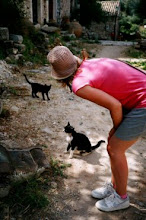
- 23 December 1834 - Joseph Hansom of London receives patent for Hansom cab. The "cab" bit is short for cabriolet. They were popular until the 1920's, when the affordable motor car was coming into its own.
- 24 December 1922 - The London Coliseum came into being as a variety theatre. It was unusual for the time in that it didn't have a pit - not the orchestral type, but the type which housed the rowdy working classes.
- 25 December 1066 - William the Conqueror crowned King of England.
- 26 December 1198 - French bishop Odo van Sully condemns Zottenfeest. If anyone knows what this means, please let me know. I can't find a thing about it!
- 27 December 1871 - The world's first cat show - the National Cat Club Show - is staged at the Crystal Palace in London.
- 28 December 1895 - The world's first moving picture theatre opens in Paris, run by Antoine Lumière - father of Louis and Auguste, who invented the cinematograph. 30 people watched films on ordinary French life and some ran out at a film showing a train moving head on towards them.
- 29 December 1940 - The first devastating incendiary bomb raid hits London.
Brought to you by http://www.quirkytravel.com. Events/births etc for today in history (a whole week's worth) are generally London or Paris based, but only if I can find interesting ones to report!

